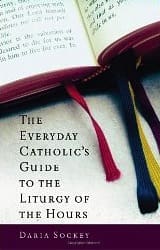If you’re like any number of Catholics, you’ve heard of the breviary, the Divine Office, and the Liturgy of the Hours. Maybe you’ve tried your hand  at an Hour or two. Maybe you’ve even succeeded.
at an Hour or two. Maybe you’ve even succeeded.
But maybe, like many of our fellow Catholics, you’ve failed and given up, coming to the conclusion that those who devote themselves to the Liturgy of the Hours are either insane or much less busy than you are. If this is where you are, I hope you will find encouragement here to re-engage or begin a new adventure into the unceasing prayer of the Church.
Since the beginning of my journey into Catholicism, I have prayed the Hours, and I can assure you that I am neither insane nor idle. What I am is grateful for the tremendous blessings of this daily practice – and how it has drawn me more deeply into the liturgical cycle of the Church. Each morning during any season, I am led through rich history and prayers of the people of God, and hopefully, I am open to allow each element to shape my day as I seek to immerse myself in the rhythm of the Church.
“The opportunity to sanctify time is something we should welcome,” writes Daria Sockey in her just-released book, The Everyday Catholic’s Guide to the Liturgy of the Hours. “Certainly we all value our time. We are always complaining that we do not have enough of it. We are disappointed with ourselves when we realize we’ve been wasting it. We marvel at the swiftness of its passing. We cling to our day planners and calendars as to anchors in a storm. So it makes sense to dedicate this valuable commodity – the fleeting hours of morning, noon, evening, and night – to our Creator.”
The challenge of time is a real one. However, once you get used to how to navigate in and through the daily prayers, you will find that the time commitment is really minimal. Even so, as you mature in the Hours and mental prayer, you might find yourself enjoying more time than you had planned. It really is one of the lesser-known treasures of the Church, and those who discover it and persevere past the mechanics rarely leave it behind.
In just over 100 pages, Sockey manages to do what scholars and theologians have tried to do for hundreds of years: She convinces the rest of us that praying the Liturgy of the Hours is neither impossible nor fruitless. She makes a case for it, chapter by chapter, while explaining the history, giving instruction, and even sharing a chuckle or two.
Within the pages of Everyday Catholic, you’ll find inspiration and motivation. You’ll find the things you probably learned in a class somewhere at some time – yet put into terms that you won’t be able to forget. How about the image of Night Prayer as Mary tucking you into bed? Or the encouragement that it’s better to pray “badly” than to get into the habit of being “out of habit” with praying the Hours?
Sockey isn’t putting on a front or faking it for publication. She’s a mom of many, a grandmother, and a struggling pray-er of the Divine Office. She maintains, on page 114, that “by now you know far more about the Liturgy of the Hours than most Catholics do,” and she follows with the admonition, “If you haven’t started [praying the Liturgy of the Hours] yet, please start now, before the interest that inspired you to read this book wears off.”
You’ll find here a combination of catechesis and prayer aid, with encouragement on the side. It’s both a guide and a love story, and belongs on every Catholic’s reading list. Pick up your copy, and let the beautiful adventure of the Liturgy of the Hours begin – or begin anew – in your own life.
The Everyday Catholic’s Guide to the Liturgy of the Hours, by Daria Sockey (Servant Books, 2013), 116 pages
+
Art for this post: The Everyday Catholic’s Guide to the Liturgy of the Hours by Daria Sockey book cover, used with permission. Feature image art: St. Thomas Aquinas centered detail of All Saints The Forerunners Of Christ With Saints And Martyrs, Fra Angelico, 15th century, PD-US author’s life plus 100 years or less, Wikimedia Commons.




